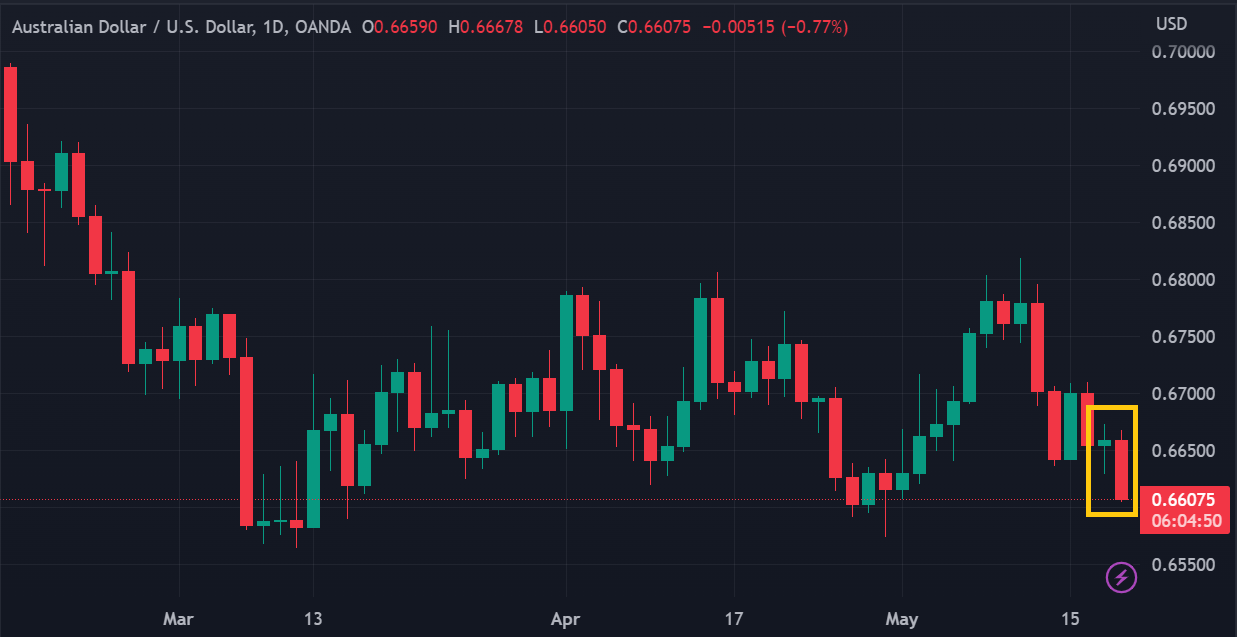AUD/USD has fallen more than 0.7 percent since the morning opening, reaching a low level of 0.6605.
The Australian dollar became the worst-performing major currency in Thursday's (May 18) trading session due to global risk sentiment, weak domestic economic data, and the appreciation of the US dollar. AUD/USD fell more than 0.7 percent since the morning opening, reaching a low level of 0.6605 during the early New York session.
 AUD/USD Daily chart via TradingView
AUD/USD Daily chart via TradingView
The Australian Bureau of Statistics (ABS) reported a significant increase in Australia's unemployment rate from 3.5% to 3.7% in April 2023, contrary to the previous consensus expectation of no change. Employment also decreased by 4.3k during that period, while the consensus forecasted a job creation of 25.0k.
Market participants view this rise in Australia's unemployment rate as a signal that the central bank will not raise interest rates further for the remainder of 2023, following the unexpected rate hike announcement earlier this month. Speculation about this has led to a decline in the Australian dollar exchange rate in the forex market. However, economists caution that one data release alone does not guarantee any specific policy action from the Reserve Bank of Australia (RBA).
Some economists argue that Australia's labor market conditions are still too tight and have not reached the ideal situation desired by the RBA for sustained inflation control. Others suggest monitoring other critical economic data releases from Australia to speculate on the central bank's next policy moves.
"Our Australian economic team notes that the upcoming retail trade data (May 26) and the monthly CPI indicator for April (May 31) will be important to monitor ahead of the RBA meeting on June 6," said Carol Kong, currency strategist at Commonwealth Bank of Australia.
Warren Hogan, an Australian macroeconomics expert, states that this data shows the "first signs" of easing in the labor market. However, he also emphasizes the need for labor market data from the upcoming months to ensure that the projected decrease in inflationary pressures, which the RBA expects, is indeed realized.

 Dedicated FREE FOREX VPS
Dedicated FREE FOREX VPS Free FOREX Virtual Private Server
Free FOREX Virtual Private Server MT4 Demo Contest, Get $500
MT4 Demo Contest, Get $500 Sign Up for an Account, Claim 60% Deposit Bonus
Sign Up for an Account, Claim 60% Deposit Bonus Free MT4/MT5 VPS 2024
Free MT4/MT5 VPS 2024 Send E-mail and Get Free Merchandise
Send E-mail and Get Free Merchandise $1K Refer a Friend Bonus for Pepperstone Pro clients
$1K Refer a Friend Bonus for Pepperstone Pro clients Maximize Your Earnings with 100% Deposit bonus
Maximize Your Earnings with 100% Deposit bonus Trade to Win, $5,000 Monthly Demo Contest
Trade to Win, $5,000 Monthly Demo Contest Claim 30% + 15% Deposit Bonus from LiteFinance
Claim 30% + 15% Deposit Bonus from LiteFinance






